Seagate's Momentus XT Reviewed, Finally a Good Hybrid HDD
by Anand Lal Shimpi on May 24, 2010 9:31 AM EST- Posted in
- Storage
- SSDs
- Seagate
- Momentus XT
- Hybrid Drive
- SSHDs
The Test - Real World First
Before we get to our usual benchmarks I put together a few hand timed tests to help convey the experience the Momentus XT offers. Seagate badly wants the world to think that the Momentus XT is SSD-like in its performance. In my opinion it performs more like a fast hard drive rather than an SSD, but regardless of what you want to call it the tests below are designed to help convey the user experience.
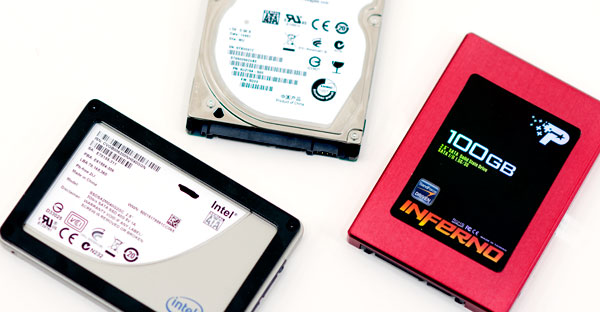
To aid in our comparison I've thrown in two SSDs: the Intel X25-V and the Patriot Inferno. The X25-V is a small, but affordable SSD while the Inferno is based on the SandForce SF-1200 controller making it one of the fastest and most expensive consumer SSDs we've tested. We've also got the new 600GB VelociRaptor and Seagate's own Momentus 5400.6, a fairly standard 5400RPM 2.5" drive for comparison. While a better comparison would have been a modern 7200RPM 2.5" drive, we didn't have one handy in time for this review. The 5400.6 should give you a general idea of how all 2.5" drives will perform though; 7200RPM drives will be faster but not by a huge margin.
These are mature results, measured on the third of three runs so the Momentus XT has more than enough time to learn (between each run I rebooted the machine).
| CPU | Intel Core i7 965 running at 3.2GHz (Turbo & EIST Disabled) |
| Motherboard: | Intel DX58SO (Intel X58) |
| Chipset: | Intel X58 + Marvell SATA 6Gbps PCIe |
| Chipset Drivers: | Intel 9.1.1.1015 + Intel IMSM 8.9 |
| Memory: | Qimonda DDR3-1333 4 x 1GB (7-7-7-20) |
| Video Card: | eVGA GeForce GTX 285 |
| Video Drivers: | NVIDIA ForceWare 190.38 64-bit |
| Desktop Resolution: | 1920 x 1200 |
| OS: | Windows 7 x64 |
Our first test is a timed boot. You are looking at the time from initial OS load (not POST) to getting a cursor at the Windows 7 desktop.
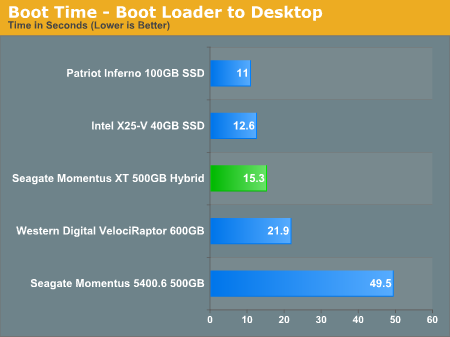
The Windows 7 boot process is a very read intensive task that's easy for the Momentus XT to learn. Seagate may be on to something here, the Momentus XT is much more like a SSD than a HDD in this test. Even the VelociRaptor is no match for it. The SSDs are still faster, but they don't offer nearly the same capacity as the hybrid drive. Compared to a standard 2.5" notebook drive the Momentus XT is a no brainer, it's in a league of its own.
Adobe's Photoshop CS4 is a great application launch test as it can take a fairly long time to load. Here we're just timing the period from clicking on the CS4 icon to ending up at the Photoshop workspace.
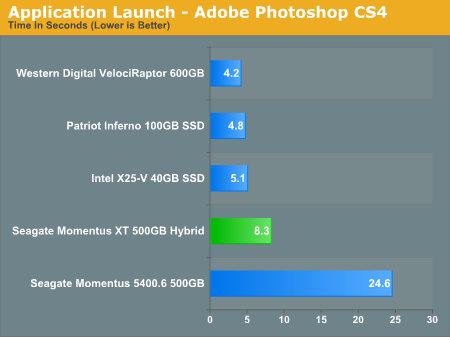
The new VelociRaptor is slightly, but consistently faster than both of the SSDs in this chart. It does still have a few tricks left up its sleeve. The Momentus XT is about half the speed of the SSDs and 10K RPM HDD here, but much faster than the 2.5" 5400RPM notebook hard drive. It's noticeably faster than your standard notebook HDD but it does feel slower than a SSD. That is an important distinction as throughout my experience with the drive it felt like a fast hard drive, rather than an SSD. Part of the reason there is because the NAND isn't used for writes, so you still get the high latency response time whenever there are any random writes happening in the background.
Our standard Photoshop CS4 performance test in our reviews is optimized for comparing CPUs and as such it's set to only record the previous action. With only one level of history, the benchmark is not nearly as disk intensive as Photoshop can get. For this test I ran our CS4 benchmark but left the application at its default setting of remembering the previous 20 actions. With more to keep track of, performance goes down while the reliance on a fast storage subsystem goes up.
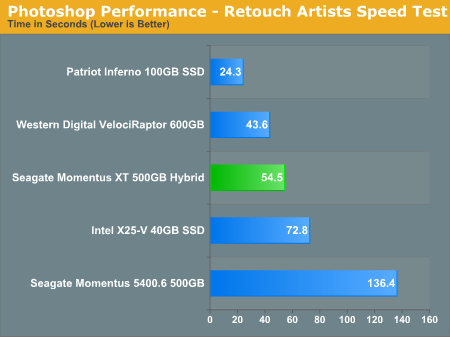
The X25-V is penalized by having a very low sequential write speed. The combination of heavy reads and writes means that the Momentus XT behaves more like a normal hard drive and less like an SSD. The 4GB SLC read cache does help though, while the hybrid drive isn't faster than the VelociRaptor it's pretty close for being a 2.5" notebook drive. The 100GB SandForce drive is much faster than anything else here, but it does offer 1/5 the space at 2.5x the cost of the Momentus XT.
For the next test I wanted to see how well the Momentus XT would cache a single large file. I timed how long it took to load a 70MB Excel sheet:
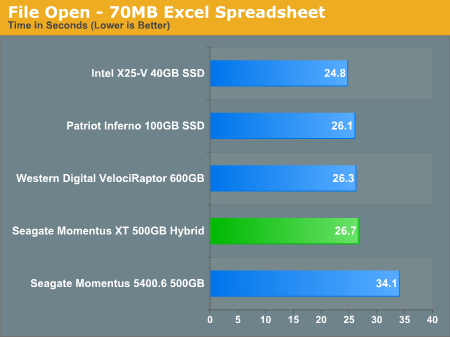
The results are a lot closer than you'd expect. Despite having a 4GB SLC NAND read cache, the Excel load time isn't any better than the VelociRaptor (although it is faster than the 2.5" 5400RPM drive). The upper bound in performance is set by the SSDs so it looks like the Momentus XT's cache does as much as physically possible to improve performance, we're simply bound elsewhere.
My favorite test for showing the usefulness of an SSD is to load a bunch of applications immediately after booting to the desktop. On a system with a hard drive there are usually a lot of disk accesses right after you hit the desktop that will slow down any application launches. A well made SSD acts like nothing is going on in the background. But what about the Momentus XT?
To test it I threw Internet Explorer, Outlook 2007, Access 2007, Excel 2007, PowerPoint 2007, Word 2007 and Photoshop CS4 in the startup folder of my testbed. The times below measure how long it took to load all of those applications immediately after boot:
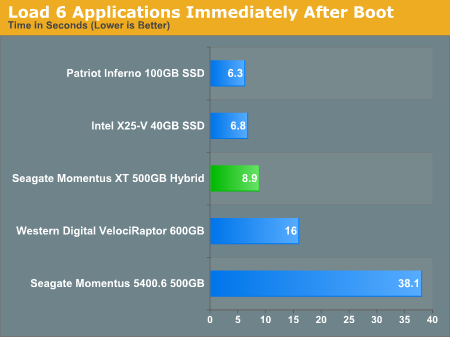
I'm impressed. While it's not quite as fast as an SSD, Seagate's Momentus XT is faster than any hard drive here. It's fast enough in this test where you might even consider using one in a desktop instead of a VelociRaptor. There is still the issue of random write performance (it is a 7200RPM 2.5" drive after all) but this is very good. It's because of this that Seagate believes the Momentus XT is delivering a SSD-like experience and in this test I'd have to agree.










120 Comments
View All Comments
Toray - Friday, May 28, 2010 - link
ASUS G Series G73JH-A3Impulses - Friday, May 28, 2010 - link
Interesting, Amazon (pre-order) and Newegg (ETA 6/1) listings for these drives are already undercutting the prices Anand posted by a good $20-ish... Newegg lists the 500GB drive at $130 and Amazon is offering pre-orders on the 320GB at like $115. If Seagate maintains that aggressive pricing they could certainly displace the low end SSD market for a while...I'm still happy with the X25-V on my netbook but I'm the sort that doesn't mind carrying an external drive on a long trip. You really gotta wonder why hybrid drives like this haven't shown up earlier, from a technical standpoint they seem simpler than any SSD (no need for TRIM, etc.).
Hrel - Sunday, May 30, 2010 - link
I'd really like to see you compare two desktop 3.5" drives, 7200rpm 32MB cache drives to this drive. Then stripe RAID them together and compare that RAID to this one drive. Then RAID two of these together and compare it to the two desktop drives in RAID. Basically, I'm gonna set up a striped RAID on my desktop, I wanna know if I'd be better off using two 3.5" all mechanical drives or if I should go for two of these hybrid drives. 1TB is plenty for me.htwingnut - Sunday, May 30, 2010 - link
Great article and this looks like a winner for any performance laptop. However, it would be good to see a comparison with a 7200RPM drive instead of 5400RPM since anyone considering this would rather see that comparison. At least I would. Would it be worth updating my exsiting Seagate 500GB 7200RPM HDD for one of these?Hauken - Sunday, May 30, 2010 - link
Hey Anand,Great article, thanks!
I'm going to replace the optical drive in my Macbook Pro with a HDD and am not sure if I should go SSD + Mechanical or get two of these and stripe RAID it?
How do you think the RAID performance of two Momentus XT would be? That way you'd have 8GB of NAND right, so... a bit more "SSD like" I suspect? The cost for that would be 260 US... not bad for 1TB of fast storage in a laptop...
Comments from you and others on this would be much appreciated, cheers!
Rocket321 - Monday, June 7, 2010 - link
Amazon has the 500gb drives for pre-order $129 free ship.I honestly hope these things sell like hot cakes just to send a message to drive makers that INNOVATION is something people want and are willing to pay a little more for. I will seriously consider one of these for my existing laptop, as well as a budget way to get WDVR performance on my desktop.
Thanks for the great review Anand.
aneirin - Thursday, July 1, 2010 - link
And now on Windows 7 Professional 64 bit, my devic e manager sometimes shows only the drive, sometimes shows 2 additional drives (which I am assuming are the cache).I am assuming I installed the drive in the wrong way. I KNOW this is not a tech support forum, but since the crowd is pretty knowledgeable, I thought I might ask ... any help is appreciated.
Regards,
Nelson I. Reyes
GTEC LLC
HipPriest - Monday, August 16, 2010 - link
I have to disagree with your recommendation of this technology, unless you are constantly rebooting your system you are better off just using the RAM cache. Do people really reboot that much? I typically only need to reboot every couple months (basically for security updates in the kernel). Even my laptops just use sleep mode.With only 4GB of read-only cache, you might as well just buy RAM. On the other hand, if they made the flash size large enough that it wasn't affordable to purchase the same amount of RAM, or if they allow write caching, this hybrid technology would be worth while.
Seedubs - Monday, December 27, 2010 - link
Umm.. I do! The allure of the faster boot time has caused me to retrofit all of my Mac g5's as well as laptops with sdd tech. I am in recording, so I can tell you with certainty that waiting for the damn rig to reboot with a room of testy people is nerve wracking at best. With audio programs one is always moving from one to the other all the time to get at all of the different attributes in the myriad of different programs. They all quarrel with each other for the rights to the audio hardware, thereby requiring a reboot. Over and over . All day long. Ya I guess you could manually switch the iac buss but that only works half the time.This technology is a godsend to artists and engineers like me. If you can afford one( ssd) it will revolutionize your workflow. I currently run a 240 SSD as my native drive. Logic takes up 60 gig. Protools takes it's share and before you know it, you are close to the edge with respect to reserve space. Enter Momentus. This is where all of the rest of my sample libraries are stored. Maybe it's a POS. I will let you know, right after I restart this thing.
name99 - Saturday, September 11, 2010 - link
"most likely via a history table of LBAs and their frequency of access"I don't think so. If you look at the number of LBs that exist, it is freaking HUGE --- even if you cluster at, say, 4KB clusters, on a 500GB drive you have about 125 million of these and that's still a not insubstantial amount of RAM --- and an array which then has to be ordered dynamically to do anything useful.
The way I would handle this is to treat the thing like a CPU cache with sets and ways. If we treat it as non-associative, then we have each block of cache (whether a "block" is 512 bytes or 4KB) corresponds to ~128 blocks of disk. The absolute dumbest way to do things is that, for each block, as the block is read, if it's not in the cache it's put in it's appropriate single pre-ordained place --- like a simple-minded 1-way cache.
But of course that's the dumbest way of doing things. Much better would be to make the cache 4 or 8 way wide, and for each way to store an LRU to MRU ordering (or the various tricks CPU designers have used to fake this), then when a block is read that is not in the cache, we toss the oldest block in the cache and store the newly read block.
BUT, and this is important, this is STILL not optimal --- it's not optimal for CPUs, and it's not optimal for drives. It is, however, easy to fix in drives, harder in CPUs. The problem is streaming data. With the model described above, any sort of operation that performs a one-time run through a large file (copying/backup, or just watching a movie) is going to replace the entire cache with one-time data. I don't know what the standard ways to deal with this are, but I have an easy solution which is that, associated with each way is a small amount of RAM that stores the most recently seen blockID as a POTENTIAL candidate for the cache. So at any given time, a way contains, say, 4 blocks of good data, plus the ID of the most recent block mapped onto that way which did not hit in the cache. If the next block that does not hit in the cache is the SAME as the potential candidate, we treat that as a verification that we are not streaming, and the on this second read we move the block into the cache.
You can expand this idea, based on real-world data, to whatever works best. In particular, this scheme as exactly described is potentially fragile in that it requires two successive reads to the same block (within a particular way) without an intervening read elsewhere in the way. So it is good at keeping out streaming data, but potentially also keeps out some re-used data. You can deal with this by having the per-way pool of potential blockIDs be 2, or 3, or N in size --- when the pool is N in size, we can allow up to N-1 reads in that way to intervene between two successive reads to a block, and still catch the block.
So there is scope for some ingenuity in quite how these systems are designed. If I had to guess, my guess would be that the current system is something like 4-way associative. Not clear if they are using my idea (or some equivalent) to prevent streaming from screwing the system over. The test that should be done, which I don't see in the post, would be to time something like a bunch of app launches, THEN read 4GB sequentially from the disk, time the app launches again, and see if the time has gone down. It would not surprise me if this first round of firmware does little to nothing to prevent streaming pollution --- not least because the existing benchmarks are not testing for it. On the other hand, this also all suggests that there is scope, in time, for much better engineering to figure out the optimal number of ways for the cache, the optimal cache block size, and the optimal strategy to prevent streaming from polluting the cache.